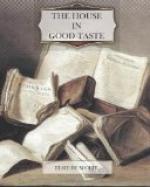[Illustration: LIGHTING FIXTURES INSPIRED BY ADAM MIRRORS]
The picture on page 118 shows the proper placing of wall fixtures when a large picture is the chief point of interest. These wall fixtures are particularly interesting because they are in the style of the Adam mirrors that hang on the recessed wall spaces flanking the chimney wall. This photograph is a lesson in the placing of objects of art. The large painting is beautifully spaced between the line of the mantel shelf and the lower line of the cornice. The wall fixtures are correctly placed, and anyone can see why they would be distressingly out of key if they were nearer the picture, or nearer the line of the chimney wall. The picture was considered as an important part of the chimney-piece before the openings for the fixtures were made.
Another good lamp is shown on the small table in this picture. There is really a reading-lamp beside a comfortable couch, which cannot be seen in the picture. This lamp, like the one in the drawing-room, is made from a porcelain vase, with a shirred silk shade on a wire frame. An electric light cord is run through a hole bored for it. If electricity were not available, an oil receptacle of brass could be fitted into the vase and the beauty of the lamp would be the same.
There are so many possibilities for making beautiful lamps of good jars and vases that it is surprising the shops still sell their frightful lamps covered with cabbage roses and dragons and monstrosities. A blue and white ginger jar, a copper loving-cup, or even a homely brown earthenware bean-pot, will make a good bowl for an oil or electric lamp, but of the dreadful bowls sold in the shops for the purpose the less said the better. How can one see beauty in a lurid bowl and shade of red glass! Better stick to wax candles the rest of your life than indulge in such a lamp!
I know people plead that they have to buy what is offered; they cannot find simple lamps and hanging lanterns at small prices and so they must buy bad ones. The manufacturer makes just the objects that people demand. So long as you accept these things, just so long will he make them. If all the women who complain about the hideous lighting-fixtures that are sold were to refuse absolutely to buy them, a few years would show a revolution in the designing of these things.
There has been of late a vulgar fashion of having a huge mass of colored glass and beads suspended from near-brass chains in the dining-rooms of certain apartments and houses. These monstrous things are called “domes”—no one knows why. For the price of one of them you could buy a three pronged candlestick, equipped for electricity, for your dining-room table. It is the sight of hundreds of these dreadful “domes” in the lamp shops that gives one a feeling of discouragement. The humblest kitchen lamp of brass and tin would be beautiful by contrast.




